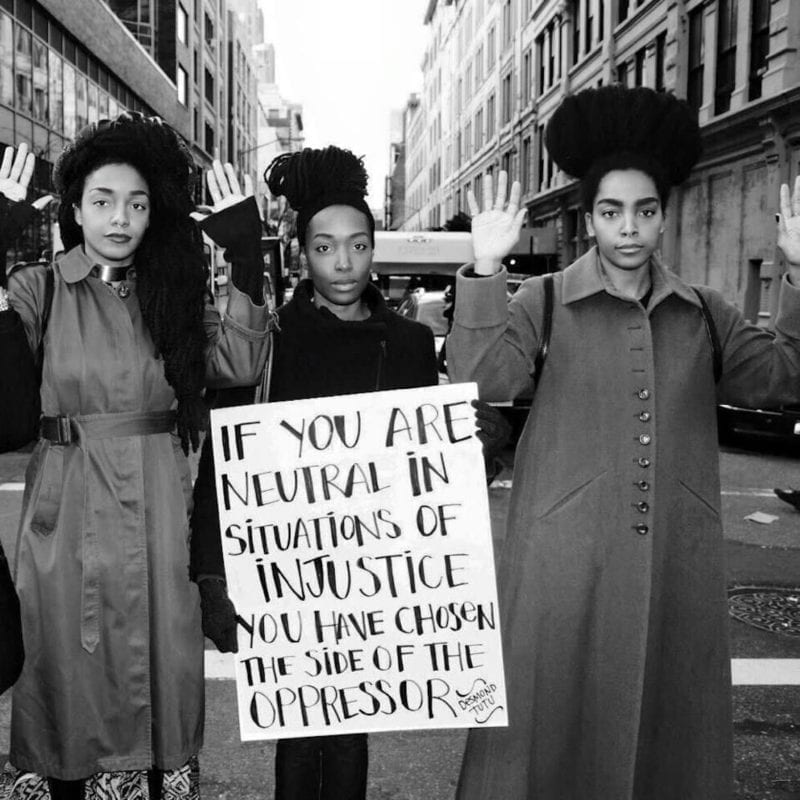Recently, American cultural discourse around race and racism has evolved from promoting an often simple, saccharine progress narrative to deconstructing systemic racism—racism demonstrated through the structures and systems of our society. Through examining sociocultural and historical dimensions of race in America, the reality of racial oppression, bias, dehumanization and systematic discrimination is evident.
The reality of racial oppression, bias, dehumanization and systematic discrimination is evident.
As a biracial Asian American woman of color and daughter of an immigrant, I have always been aware of the pernicious nature of racism. Though I have walked with a constant awareness of my “otherness,” knowing my body is deemed abject and I walk in fear of certain kinds of violence and xenophobia, I am still deeply privileged. I recognize how black people have been treated with multivalent brutality for hundreds of years—how language, law and systems have been developed to dehumanize black people.
James Baldwin said, “Not everything that is faced can be changed, but nothing can be changed until it is faced.” It is up to all non-black Americans to face and learn our country’s brutalizing history. When people are murdered and the institutions that claim to serve actually oppress, “equality” and “progress” are shallow words and hollow promises. It is the cultural equivalent of painting a house with broken pipes, a faulty foundation and frayed wiring and calling it renovated. It may look fine to some people, but it is still, in fact, a dangerous place to live.
When the institutions that claim to serve actually oppress, “equality” and “progress” are shallow words and hollow promises.
Here are some examples of systematic racism that have oppressed the black community throughout history.
Problems with Reconstruction
The Black Codes were a series of laws passed in the South between 1865 and 1867 designed to cement the oppression of black citizens after the Civil War by denying them equal rights in voting, education, marriage, property ownership and more. New post-war legal and law enforcement systems were filled by former Confederate soldiers.
With the leading of President Andrew Johnson and the Freedmen’s Bureau, the South began a “convict leasing” program—targeting black citizens and convicting them of petty offenses and forcing them to work on plantations run by former slave owners.
Jim Crow Laws
Jim Crow laws, named after a black minstrel character (minstrel shows were popular performances in which the actors wore blackface and portrayed demeaning caricatures of black people), began around 1877 and made racial segregation the law in every aspect of life. Everything from textbooks to cemeteries were segregated.
Punishment for violating these laws resulted in the incarceration or murder of black people. The Equal Justice Initiative estimates that nearly 4,000 black people were lynched in the Jim Crow South.
The Red Summer
In 1919, a rash of white supremacist violence swept through American cities ranging from Chicago to New Orleans. Threatened by the improving social status of black veterans following WWI, white veterans instigated violent rampages against black communities, resulting in 25 riots, at least 97 recorded lynchings and more than 250 murders.
In the Arkansas Elaine Massacre, at least 200 black people were killed (though only 11 deaths were reported at the time) by a white mob in a violent attack to prevent the black community from creating a farm union. No perpetrators were held accountable.
The Burning of Black Wall Street
Tulsa’s Greenwood District was an affluent community known as “Black Wall Street,” in which a single dollar could pass within the community upwards of 36 times. Residents owned their own homes, businesses, cars and planes. In 1921, following unsubstantiated allegations that a black man attempted to assault a white woman, an armed throng of white people descended upon the district, throwing bombs, looting, burning buildings and homes and murdering black residents, in what is now called the Tulsa Race Massacre. The survivors never received reparations.
Exclusion from the G.I. Bill
The G.I. Bill (The Servicemen’s Readjustment Act of 1944) provided World War II veterans with education incentives, job training, low mortgages and loan benefits, but black veterans were largely excluded from all of the above. Banks would not give loans to businesses in historically black neighborhoods. Black people were denied purchasing homes in new suburban communities, as well as pre- and post-war employment opportunities and more.
The Murder of Emmett Till
On August 28, 1955, Roy Bryant and J.W. Milam kidnapped, beat and murdered Emmett Till, a 14-year-old black child who was on summer vacation visiting his uncle in Mississippi. Emmett’s mother decided to hold an open-casket funeral and release photos to Jet Magazine to call national attention to the atrocity.
The murderers were put on trial, in which they claimed Emmett whistled at Bryant’s wife, Carolyn Bryant Donham. They were absolved of all charges by an all-white jury. In 2017, 62 years later on her near the end of her life, Carolyn confessed that Emmett never whistled at her.
Bloody Sunday
In 1965, 600 civil rights demonstrators began a series of peaceful marches from Selma to Montgomery to demand equal voting rights for black citizens. On March 7, now known as Bloody Sunday, Alabama state troopers brutally attacked the demonstrators, including now-Congressman John Lewis, with tools of excessive force, including tear gas and batons.
Nixon’s Southern Strategy
The Southern Strategy was adopted by the Republican Party to attract white Democratic voters in the South by speaking in coded language around racial issues, also known as “dog-whistle politics.” By speaking to the “silent majority of Americans,” Richard Nixon popularized this rhetoric in the 1968 presidential election by replacing overtly racist language with words like “law and order.”
Therefore, Nixon contrasted his candidacy with that of third-party candidate George Wallace, the virulently racist former Alabama Governor and made racist ideas more palatable and socially acceptable by concealing them.
The War on Drugs
In 1971, Nixon called drug abuse in the United States’ “public enemy number one.” This rhetoric began a new, more pernicious wave of the war on drugs. President Ronald Reagan later pushed aggressive anti-drug policies, which were more harshly applied to black and brown communities. This included increased surveillance, sentencing and incarceration rates (even though studies have shown white people are more likely to abuse drugs.) For example, crack cocaine was punished with a five-year mandatory minimum, but an individual found with powder cocaine would have needed 100 times more of the drug to receive the same sentence.
Three-Strikes Bill
President Bill Clinton’s 1994 Crime Bill included “three strikes policy” for repeat felony offenders, in which “you’re out” meant incarceration for life. During this time, the Clinton Administration also promoted the myth of the “superpredator,” which demonized black youth. These efforts did not decrease crime rates. Rather, they ballooned rates of incarceration and plea bargains due to pressure on the legal system. The Equal Justice Initiative reports that the prison population has increased from 200,000 in 1972 to 2.2 million today.
This is by no means an exhaustive list, but these examples indicate how cultural, political and economic factors shape systemic racism in the United States. In the words of Maya Angelou, “When you know better, do better.” We need to rebuild a house that is safe for black and brown Americans: systems which not only protect, but also advocate for anti-racism, flourishing and true equality.
How many of these historic events in history did you already know? What books, podcasts, movies or other resources would you share with someone who wants to learn more?
Archived Image via Bipartisan Report











